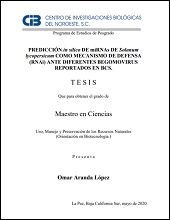Mostrar el registro sencillo del ítem
PREDICCIÓN in silico DE miRNAs DE Solanum lycopersicum COMO MECANISMO DE DEFENSA (RNAi) ANTE DIFERENTES BEGOMOVIRUS REPORTADOS EN BCS.
| dc.contributor.author | Aranda López, Omar | |
| dc.date.issued | 2020-05 | |
| dc.identifier | https://cibnor.repositorioinstitucional.mx/jspui/handle/1001/1946 | |
| dc.identifier.uri | http://dspace.cibnor.mx:8080/handle/123456789/3042 | |
| dc.description.abstract | "El RNAi o silenciamiento génico, es un sistema que se ha documentado para el control de infecciones begomovirales en cultivos de interés agrícola; pero su nivel de eficiencia es determinado por el uso de construcciones genéticas, las cuales contienen secuencias blanco al begomovirus, por lo que, el diseño de estas construcciones son de gran importancia; dentro del amplio número de investigaciones para este tema, el análisis in silico de los miRNAs tiene un rol importante, donde se agrupan criterios de selección para generar estas construcciones in silico. El objetivo de este estudio, es una predicción in silico de los miRNAs en Solanum lycopersicum que pueden unirse al genoma de los begomovirus ToChLPV, TYLCV, SLCuV y PepGMV reportados en BCS, con el potencial de utilizarse posteriormente en un sistema de silenciamiento génico, contra infecciones begomovirales mixtas. Con los resultados de este análisis in silico, se identificaron diferentes miRNAs que pueden unirse al genoma de los cuatro begomovirus mencionados, de los cuales algunos tienen como objetivo múltiples genes/región. El mayor número de sitios blanco para los miRNAs se encontró en los genes C1, C4 y la región intergénica (IR). El análisis de la similitud mostró los valores más bajos de identidad para las mismas regiones (C1, C4 e IR). Mientras que el análisis de diversidad y presión de selección mostraron el valor más alto de diversidad (π) para C4, C1 y V1. El gen C4 mostró estar bajo un mayor efecto de selección positiva, mientras C1 y V1 tienen efecto de presión negativa. Lo que se reflejó en una mayor acumulación de mutaciones sinónimas para V1/C1 y no sinónimas para C4. Estos datos refuerzan la idea de que los miRNA candidatos juegan un importante papel en el silenciamiento de estos begomovirus de manera natural y en infecciones mixtas. Con este análisis de predicción in silico se propone como candidatos a mir395 y mir9477 para el diseño de construcciones que activen el silenciamiento génico, porque que tienen sitios objetivos en TYLCV, SLCuV, PepGMV, ToChLPV, y sobretodo porque se ha documentado que estos miRNAs no tienen efectos secundarios para el hospedero." | es |
| dc.format | es | |
| dc.language.iso | spa | es |
| dc.publisher | Centro de Investigaciones Biológicas del Noroeste, S.C. | es |
| dc.rights | Acceso abierto | es |
| dc.subject | miRNAs, BGVs, infección mixta, RNAi, ToChLPV, SLCuV, PepGMV, TYLCV, in silico | es |
| dc.subject | miRNAs, BGVs, infection mixed, RNAi, ToChLPV, SLCuV, PepGMV, TYLCV, in silico | es |
| dc.subject.classification | VIRUS | es |
| dc.title | PREDICCIÓN in silico DE miRNAs DE Solanum lycopersicum COMO MECANISMO DE DEFENSA (RNAi) ANTE DIFERENTES BEGOMOVIRUS REPORTADOS EN BCS. | es |
| dc.type | masterThesis | es |
| dc.dirtesis.grado | Maestría en Ciencias en el Uso, Manejo y Preservación de los Recursos Naturales | es |
| dc.dirtesis.disciplina | Biotecnología | es |
| dc.dirtesis.universidad | Centro de Investigaciones Biológicas del Noroeste, S.C. | es |
| dc.dirtesis.facultad | Posgrado en Recursos Naturales | es |
| dc.description.abstracten | "The RNAi or gene silencing, is a system that has been documented for the control of begomoviral infections in crops of agricultural interest; but its level of efficiency is determined by the use of genetic constructions, which contain target sequences to the begomovirus, so that, the design of these constructions is of great importance. Inside the wide number of research for this topic, the in silico analysis of miRNAs plays an important role, where are grouped selection criteria to generate these in silico constructions. The aims of this study, is an in silico prediction of the miRNAs in Solanum lycopersicum that can bind to the genome of the begomoviruses ToChLPV, TYLCV, SLCuV and PepGMV discribed for BCS, with the potential to be used later in a gene silencing system, against mixed infections of begomovirals. With the results of this in silico analysis, were identified different miRNAs that can bind to the genome of the four mentioned begomoviruses, some of which target multiple genes or region. The largest number of targeted sites for miRNAs was found in genes C1, C4 and the intergenic region (IR). The similarity analysis showed the lowest identity values for the same regions (C1, C4 and IR). While the analysis of diversity and selection pressure showed the highest value of diversity (π) for C4, C1 and V1. The C4 gene showed to be under a greater positive selection effect, while C1 and V1 have an effect of negative pressure. This was reflected in a greater accumulation of synonymous mutations for V1/C1 and not synonymous for C4. These data reinforce the idea that candidates miRNAs play an important role in the silencing these begomoviruses naturally and in mixed infections. With this in silico prediction analysis, mir395 and mir9477 are proposed as candidates to the design of constructions that activate gene silencing, because they have targeted sites in TYLCV, SLCuV, PepGMV, ToChLPV, and above all because been documented that these miRNAs have not secondary effects for the host." | es |

